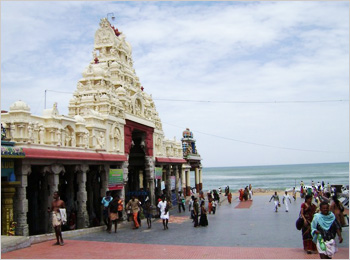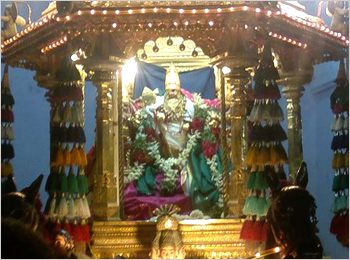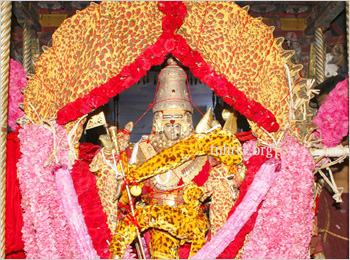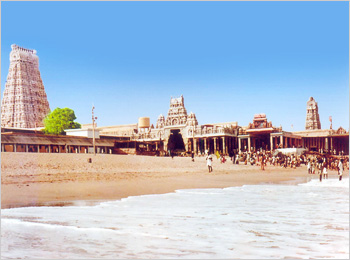- Murugan
Arulmigu Subrahmanya Swami Tirukkoil
- Tiruchendur,Tamil Nadu
- View on map
- Tell us about this temple
Overview
The Tiruchendur Subramanya Swamy Temple is situated in Tiruchendur, and is dedicated to God Subramanya or Skanda. It is one of the six major abodes of God Subramanya and is the only one among the six to be near the sea, as the other five temples are situated on mountains. The town Tiruchendur once had a different puranic name of Jayanthipuram.
About the temple

The Murugan temple goes back to 2000 years or so. This is where God Muruga had camped before and after his war with the Demon king Surapadma. He worshipped God Shiva in this shrine which was built by Maya. The native red sandstone rock was used as the foundation for the temple and the long Gopuram. The temple's Vasanta Mandap is a recent addition. It has 120 columns and a central porch. The 16 pillar Ananda Vilas Mandap stands on a raised sandy cliff overlooking the sea. The Shanmukha Vilasam houses an ornate mandap with four pillars in the center. The temple's main entrance opens into the first prahara which is known as the Sivili Mandap. The Temple also has a God Venkatesa (Vishnu) shrine on the northern prahara. The main sanctum sanctorum is dedicated to God Subramanya, who gives darshan in the form of Senthil. Here the God is seen in a standing posture. Short distance away from the main shrine is a cave dedicated to Goddess Vali, one of the consorts of God Muruga. The cave also houses the idol of Dattatreya, the king of the hunter clan. The temple was re-built and improved by kings of various South Indian dynasties like the Pandya and the Chera kings.
About the deity

In Tiruchendur, God Subramanya gives darshan to devotees in the avatar of Senthil. Senthil is believed to be from Senthur since it acquired the divine significance by being the battleground for God Muruga, which latter after adding the word "Thiru" became Thiruchendur.
Legend and Stories

Legend has it that the Asura king Surapadma ruled over Veera Mahandrapuri, an island fortress. He did a severe penance asking God Shiva to bless him with immortality; God Shiva pleased with his penance gave him the wish saying that he could be killed only by Shiva's son. Having this power, the Demon king Surapadman started disturbing the Devas. The Devas complained to God Shiva to put an end to the demon's atrocities. Accepting their plea, God Shiva created a six fire-spark from his Third eye. The sparks combined to form God Muruga. Obeying God Shiva's order, he came to Tiruchendur and fought Surapadaman. At this time, Guru Bhagawan, the preceptor of the Devas, was in Tapasya in this place praying for the darshan of God Muruga. God Muruga appeared before him and learned the history of the asuras. God Muruga sent his commander-in-chief, Veerabagu to Surapadman, as his messenger. The demon refused to listen to God Muruga's message. Later, the God went with his battalion and killed him. At the behest of Guru, God Muruga continued to be here. Guru requested Viswakarma, the divine engineer, to build a temple for God Muruga.
Historical Events
A familiar local tradition runs to the effect that about 1648 AD, a race of seafaring men, identified later as Dutch, descended upon Tiruchendur and carried away the idol Shanmukhar and Siva Natarajar, thinking that they were made of gold. Their attempt at melting it proving futile, they tried to carry them away by sea. But the sea became rough, and rocked the ship violently, so the sailors threw the idols into the sea. The loss of the idols was discovered and duly communicated to Vadamalaiyappa Pillaiyyan, the local administrator of the Nayakkan ruler at Tirunelveli. A great devotee that he was, Pillaiyyan was sorely affected and knew not what to do. He ordered for a similar idol to be made in panchaloka. As the duplicate one was ready, and was on its way to Tiruchendur to be installed, in 1653 Vadamalaiappa Pillaiyyan had a dream.
Acting to the advice conveyed to him by the God, he put out to sea and following the instructions that the idol was to be found at the spot where a lime fruit would be found floating, and the place marked by the circling overhead of a kite, the bird of Vishnu. Vadamalaiappa Pillaiyyan recovered the original idol and reinstalled it in the temple in the year 1653. The replacement idol was then consecrated in the shrine of Tiruppirantîsvarar alias Venku Patcha Kovil situated east of Palamcottah (known as Murugan Kurichi). Vadamalaiappa was greatly struck by the Lord's grace in giving him this great relief, in memory of which he erected a mantapa at Tiruchendur in his name and endowed it largely for the performance of a Kattalai abhishekam and pujas for Subrahmaniam on the seventh days of Masi and Avani festivals. An inscription at the mantapa relates the incidents referred to. Among many others, kirtanas composed by Venri Malaik Kavirayar, are sung at this mantapa at the time when Shanmukhar is brought here for Ubaya Mandagappadi on the seventh day of the Masi and Avani festivals. The poem relates the incidents and their rejoicings at the Lord being got back again. "Vadamalai Venba" is another poetic panegyric on Vadamalaiappa Pillaiyyan.
Festivals
Vaikasi Visagam (May – June)
Many devotees participate in the festival. A procession of Sri Jayanthinathar with Valli and Deivanai is conducted in the night.
Avani Festival (August – September)
Devotees numbering about two lakh participate in this festival. On this Avani festival 7th, 8th and 10th day functions are more important. On the 7th, the Sikappu sathi Festival takes place. On 8th, it is the Pachai Sathi Festival and on 10th, there is a Car Festival.
Skanda Sasti Festival - 7 days (October – November)
Devotees numbering about five lakhs will participate in the above festival. On this festival occasion, devotees fast for all six days. On the 6th day Surasamharam is demonstrated. On the 7th day Thirukkalyanam to Deivanai is celebrated in a grand manner.
Masi Festival - 12 days (February – March)
More than three lakh people participate in this festival. On the 7th, the Sikappu sathi Festival takes place. On 8th, it is the Pachai Sathi Festival and on 10th, there is a Car Festival. On the 11th day, a floating festival takes place.
Timings
The temple is open from 5:00 am to 9:00 pm.
Pooja Timings
The poojas in this temple are performed as per the Kumara Thandiram Murai. Nine pooja kalams are observed daily.
|
Period |
Time |
Pooja Detail |
|
Morning |
5.10 |
Subrapadam - Thirupalli Eluchi |
|
Morning |
5.30 |
Viswaroopam Darshan |
|
Morning |
5.45 |
Dwajasthamba Namaskaram |
|
Morning |
6.15 |
Udaya Marthanda Abishegam |
|
Morning |
7.00 |
Udaya Marthanda Deeparadhanai |
|
Morning |
8.00 to 8.30 |
Kalasandhi Pooja |
|
Morning |
10.00 |
Kalasha Pooja |
|
Morning |
10.30 |
Uchikala Abishegam |
|
Noon |
12.00 |
Uchikala Deeparadhanai |
|
Evening |
5.00 |
Sayaratchai Pooja |
|
Night |
7.15 |
Arthasama Abishegam |
|
Night |
8.15 |
Arthasama Pooja |
|
Night |
8.30 |
Ekanda Seva |
|
Night |
8.45 |
Ragasia Deeparadhanai, Palliarai Pooja |
|
Night |
9.00 |
Nadai Thirukappiduthal |
Monthly Special Poojas
On the Visakam day Special Abishegam for Lord Shanmuga is performed and the procession of deity during night is conducted. Special Pooja is performed on Sukla Sashti day in every Tamil month and the procession of deity during night takes place. 108 Thiruvilakku pooja is performed on the Karthigai day every month. Special Abishegam is performed to Jayanthi Nathar and the Utsava idol is taken in the golden chariot in the night.On the first day of every Tamil month, Ganapathy Homam and Special Pooja are performed. The Utsava idol is taken in procession during night.On the last Friday of every Tamil month Special Pooja and procession of Utsava idol is conducted. On the first day of Chithirai month Annabhishegam and Special Pooja are performed and a procession of Utsava idol is conducted during night.During the Purattasi month Navarathiri festival is conducted for 9 days. On the first day of the Iyppasi month Annabhishegam and Special Poojas are performed and the procession of Utsava idol is conducted. On the Panguni Uthiram day the Thirukalayanam of Arulmigu Valli is celebrated.
|
Pooja Detail |
Time |
|
First day of "Chittirai" month sanctum sanctorum door will open |
5.00 AM |
|
Last Friday of every month sanctum sanctorum door will open |
4.00 AM |
|
"Vaigasi Visakam" sanctum sanctorum door will open |
1.00 AM |
|
Next day of "Vaigasi Visakam" sanctum sanctorum door will open |
4.00 AM |
|
"Aavani Festival" first day sanctum sanctorum door will open |
1.00 AM |
|
"Aavani Festival" second day sanctum sanctorum door will open |
3.00 AM |
|
"Aavani" festival seventh day sanctum sanctorum door will open |
1.00 AM |
|
"Iyppasi Vishu" sanctum sanctorum door will open |
5.00 AM |
|
"Deepavali Festival" sanctum sanctorum door will open |
3.00 AM |
|
"Kantha Sasti" first day sanctum sanctorum door will open |
2.00 AM |
|
"Kantha Sasti" second day sanctum sanctorum door will open |
3.00 AM |
|
"Kantha Sasti" third day sanctum sanctorum door will open |
3.00 AM |
|
"Kantha Sasti" fourth day sanctum sanctorum door will open |
3.00 AM |
|
"Kantha Sasti" fifth day sanctum sanctorum door will open |
3.00 AM |
|
"Kantha Sasti" sixth day sanctum sanctorum door will open |
1.00 AM |
|
"Kantha Sasti Thirukalayanam" sanctum sanctorum door will |
3.00 AM |
|
First day of the month of "Karthigai" sanctum sanctorum door will open Udaya Marthanda Abishegam |
3.00 AM |
|
"Margazhi" month sanctum sanctorum door will open |
3.00 AM |
|
During "Thiruvadirai" in the month of "Margazhi" sanctum sanctorum door will open Udaya Marthanda Abishegam |
2.00 AM |
|
English New Year sanctum sanctorum door will open |
1.00 AM |
|
Pongal festival sanctum sanctorum door will open |
1.00 AM |
|
Kaanum Pongal sanctum sanctorum door will open |
4.00 AM |
|
"Tai Poosam" sanctorum door will open |
2.00 AM |
|
Preceeding day of "Tai Poosam" festival sanctum sanctorum door will open Udaya Marthanda Abishegam |
4.00 AM |
|
"Maasi" festival first day sanctum sanctorum door will open |
1.00 AM |
|
"Maasi" festival second day sanctum sanctorum door will open |
3.00 AM |
|
"Maasi" festival seventh day sanctum sanctorum door will open |
1.00 AM |
|
"Panguni Uttiram" sanctum sanctorum door will open |
4.00 AM |
Vows and Offerings
Devotees who take a vow place their offerings during festival and other days. They fast and carry Kavadi, Palkudam, offer Abishegam etc. to the Lord. The Golden Chariot procession, Chandana Lebanam, Dharabhishegam, Dharahomam are performed by devotees in fulfilment of their vows. Devotees who perform such austerities get relieved of their mental worries; the unmarried get married; and the childless beget children by the grace of Arulmigu Subramania Swamy.
Social Services
Karunai Illam
An orphanage for children is run by the temple and free boarding, lodging and education facilities are provided to 125 children from the temple funds.
Nadaswara Training School
About 10 students have been trained in this school and the expenses are met from the temple funds.
Devara Isai Training School
10 students are learning in this school and their expenses are met by the temple funds.
Archahar Training Institutions
Temple priests are trained in this institution and their expenses are met from the temple funds.
Free Marriages
Free marriages are conducted for the poor and Adi Dravida people at an estimated expenditure of Rs. 3000/- per couple from the temple funds.
Religious Activities
Religious discourses are conducted every day evening. Thirukkural classes are conducted every Sunday between 10.00 A.M. and 11.00 A.M. Religious education classes are conducted every Sunday between 11.00 A.M. and 12 Noon.
Rare Facts
Tiruchendur is the only Muruga temple where Raja gopura is situated in western gate. This temple was not constructed by Kings, it was built by three holy saints. This temple is also the largest temple among all the temples built by saints.The Tiruchendur temple does not have any eastern gateway contrary to all Hindu temple architecture. This is the only temple in Tamil Nadu where sanctum sanctorum is below the ground level. The 133 feet Rajagopura,built in the shores of Bay of Bengal,very near to the sea, just within 200 meters is still a mystery and an outstanding example for the Tamil temple architecture and an example for extreme civil engineering of Ancient Tamils.
Nearby Places to visit
Navathirupathi
There are nine Srivaishnava Temples located near Tiruchendur. These temples together are known as Navathirupathis. These temples are Srivaikuntam, Thenthirupperai, Thiru Puliankudi, Thiru Kurugoor, Thiru Kulanthai, Thiru Koloor, Twin Tirupati-1, Twin Tirupati-2 and Thiru Varagunamangai.
Ayyanar Sunai
The Ayyanar Sunai is located 10 kilometres from Tiruchendur. There is a natural water spring in the desert near Ayyanar Temple and it attracts local tourists.
Panchalankurichi
It is located about 58 kilometres from Tiruchendur. It is from here, according to history, that the great warrior Veerapandiya Kattabomman raised his voice against the British Regime in 17th Century AD. The fort was converted into a memorial by the government of Tamil Nadu in 1974. The Sri Devi Jakkammal Temple, the hereditary Goddess of Kattabomman, is located near the fort. A cemetery for British soldiers is seen near the fort. Within the memorial, there are beautiful paintings on the walls depicting the heroic deeds of the saga.
Suchindram
The only temple that has been dedicated to Trinity, is Thanumalaya's at Suchindram. It is about 70 kilometres from Kanyakumari. The name Thanumalayan denotes a combination of the Trimurthis Sthanu. It is a synonym for Siva, Mal for Vishnu and Ayan for Brahma. It is believed that the top, middle and base of the Linga in the temple represent Siva, Vishnu and Brahma respectively. Tradition goes that Indra was purified at this place and hence the Suchindram. Suchi means Purity. There are few waterfalls like coutrallam, Thiruparapu and manimuthar dam near tirechendur
Arulmigu Kalugasalamoorthy Temple, Kalugumalai
Kalugumalai is a village situated at about 22 km from Kovilpatti, between Sankaran koil and Kovilpatti near Tirunelveli in south Tamil Nadu. This place houses the famous Kazhugachalamurthy Temple. Kazhugumalai became famous by the Thirupugazh hymns of Arunagirinathar. The village may have got its present name from the hill Kalugumalai ("Hill of the vulture"). Earlier it was known as Araimalai or Thirumalai. Even before that it was referred as Nechchuram and Tiruneccuram. Some of the epigraphs mention that there was a palace for the pandya official called Ettimannan. At the foot of the Kalugumalai a large urn-burial cemetery was found. However hundreds of urns were destroyed during limestone quarrying. Opposite the Kalugasalamoorthy Temple there is a small palace which served as local residence of Raja of Ettaiyapuram.
Arultharum Mutharamman Temple, Kulasekaranpatinam
Once upon a time, due to the curse of saint Agathiyar, The saint Varamuni has became a man with a buffalo head. The term “Magisam” means buffalo. Since he had a buffalo head, he was called Mahishasuran. With his continuous meditation and strenuous effort Mahishasuran gained more power and dominated all over the world. To condemn the domination of the Mahishasuran the saints approached the Goddess and informed the hardship done by Mahishasuran. Then with the power of Goddess there appears a female baby. The baby was named as Lalithambigai. The baby grew up within 9 days and on the 10th day she grew as Annai Parasakthi Lalithambigai with lots of anger destroyed Mahishasuran and this 10th day is being celebrated as Dusshera. The growth occurred by Annai Parasakthi during the nine days are resumed as Navarathiri. The first three days for Malaimagal, the second three days as Alaimagal, and the last three days as Kalaimagal.
Arulmigu Sankara Rameshvarar Temple
Arulmigu Sankara Rameshvarar Temple is one of the ancient temples of Thoothukudi District, the city which is considered as the industrial area of South India. Arulmigu Sankara Rameshvarar is a form of Lord Shiva. The temple is one of the oldest structures (above 700 years) in Thoothukudi. This temple is dedicated to Lord Shiva as Sankara Rameswarar and Divine Mother Shakti as Arultharum Bagampriyal Udanurai Temple. People believe "Lord Shiva" and pray to him, they get rid of all their problems, after praying to this god. The famous happening at Arulmigu Sankara Rameshvarar Temple is "Prathosam Pooja" which is famous among the Thoothukudi. The main festival of Arulmigu Sankara Rameshvarar Temple takes place in the month of Chitra. Another famous festival is Tamil New Year’s Day. This is the most famous among the Thoothukudi region. Sankara Rameswarar was worshiped by Sage Kaasiyappar, Sage Gowthamar, Sage Bharathvajar and Athiri are some more who worshipped here. As Sankara Rameswarar dissolved and made himself one with the Lord, the Linga. Thoothukudi also was the place of residence of Eripathanayanar, Pugazh Chola Nayanar.
Arulmigu Courtrallanathar Swamy Temple, Courtrallam
This temple is located at about five kilometers, away from Tenkasi, Tirunelveli - district. Ad midst of Sylvan surroundings, with the adjoining background of main falls, this Courtralanathaswami temple is found in the Courtralam Township. As Courtralam - falls is popular among the people; Sri Courtralanathaswami Temple is famous for one of its Pancha-Sabha known as Chitra - Sabha. The temple is dedicated to Sri Thiru Courtrallanathar, Thirukootachalapathi and Kuzhalvoimozhi Amman (Devi whose voice is as sweet as the music of the flute). Jack tree is the Sthala Vruksha. Saint Tirugnanasambander of 7th Century A.D. glorifies the Lord of Kutralam in 2 pathihams one of which relates to the Sthala Vruksha Other Saints Tirunavkarasar Manickavachagar Pattinathar etc., have poured forth their feelings of spiritual ecstasy in soul – stirring lyrics.
Arulmigu Nellaiappar Temple, Tirunelveli
The temple of Arulmigu Swami Nellaiappar and Arultharum Kanthimathi Ambal is situated in the heart of the city. The river Tamirabharani referred to by poets as "Porunai" flows round the town. In the distant past the town was a bamboo forest; hence it was known in those days as "venuvanam". One of the famous temples in Tamil Nadu steeped in tradition and history and also known for its Musical Pillars and other Brilliant Sculptural Splendours, this is one of the largest temples in South India. The temple complex consist of two huge temples, one for Lord Shiva (Nellaiappar temple) and the other for his consort Parvathi (Kanthimathi Ammai temple). The former temple is also called as 'Swamy Venunathar', 'Nelveli Nathar', 'Chaleevadeesar' and later by the names 'Vadivudaya Ammai' and 'Kamakottamudaya Naachiyaar'. These two temples are linked by a big terraced hall namely Sangili Mandapam that has life sized sculptures adoring the pillars. The main deity of Kanthimathi Nellaiyappar Temple is a 'Suyambu Lingam' or a Shiva Lingam which erupted from underneath the earth.
Accessibility
Airport
The temple can be accessed by air. The nearest airports are in Tuticorin (45 Mins), in Madurai (3 Hours), Trichy (4.5 – 5 hours) and Trivandrum (3.5 hours).
Railways
By rail, Tiruchendur is connected to other major cities of the country via regular trains.
Road
One can also easily get regular buses to Tiruchendur from other major cities of the country.
Temple Address
Arulmigu SubramaniaSwamy Temple,
Tiruchendur, Thoothukudi District,
Pincode - 628 215.
Significance
Devotees visit this temple to seek fulfillment of the following:-
- Protection
- Wisdom
- Energy
- Forgiveness for past deeds
- For good health
- Neutralize the malefic effects of mars
Shlokas
Shadaananam Chandana Liptha Gathram Mahorasam Divya Mayoora Vaahanam Rudrasya Soonum Suraloka Naatham Brahmanya Devam Charanam Prapadye
Meaning -I always take refuge in the 6 faced Lord Guha, who has sandal paste smeared over his body, who is broad-chested, whose vehicle is the peacock, who is Lord Shiva's son and who leads the army of the Devas.
Heyswami Natha Karunakara Dheenabandho Shree Parvatheesha Mukha Pankaja Padmabandho Shree Saadhi Devagana Poojitha Padha Padma Vallesa Nadha Mama Dehi Karaavalambham
Meaning -O! Merciful Lord Swaminatha, who cares for the poor, who is the sun to Lord Shiva's lotus face, whose lotus feet are acknowledged by Lord Vishnu and the others, Valli's Lord, please uplift me by lending me your hand.
Ariru Thadanthozh Vazhga Arumugam Vazhga Veppai Kooru Sei Thanivel Vazhga Kukkudum Vazhga Sevvel Yeriya Magnai Vazhga Aanai Thun Anangu Vazhga Maarila Valli Vazhga Vazhga Seer Adiyar Yellam
Meaning -Oh Muruga, we hail your 12 strong shoulders for they protect us from our enemies, we hail your 6 faces, we hail the Vel, your weapon that broke apart the Krounja mountain to reveal the asura in it. We hail the bird, the cock, that is part of your symbol in the flag. We hail your peacock, that takes you all over the world, we hail your consort Devyani, who was brought up by Indra's white elephant, Airavadam, we hail your other consort, the flawless Valli. And we hail your Bhaktas who worship you as a prayer.
Uruvai Aruvai Uladhai Iladhai Maruvai Malarai Maniyai Oliyai Karuvai Uyirai Gadhiyai Vidhiyai Guruvai Varuvai Arulvai Guhaney
Meaning -O Lord Muruga, you have form and you are formless, you have everything and have nothing, you who exist in the smallest, in flowers, in a bell's ring, in the light. You are the embryo, the life, destiny and fate. Bestow your blessings on us as our guru.
Timings
The temple is open from 5:00 am to 9:00 pm.
